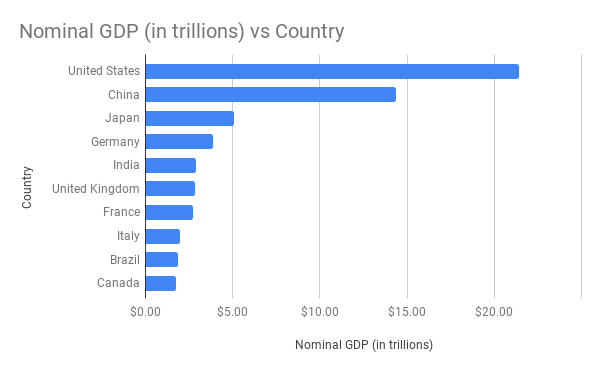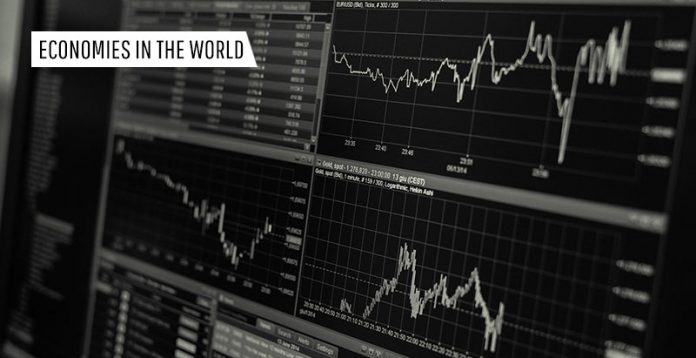If you people wonder about your country’s economy, then let us tell you first that the economic health of an individual country is estimated by the GDP (Gross Domestic Product), which is elaborated as the total market value of all the goods and services an individual nation produced in a particular year. The nominal GDP is highly useful in ranking these countries economically from high to low. The various switching in the rate of an individual country’s currency can also rise to mixed results. Here we make the latest catalog of the top 10 world economies for the year 2019-20.

10. Canada
Canada’s estimated GDP is valued at 1.8 trillion USD in 2019, making it stand in the world’s largest economies’ tenth position. The annual growth rate of Canada is expected to be 2.0% in the upcoming year. On surpassing Russia, it is just one rank ahead. There are three important sectors in Canada – the services sector, natural resource sector, and manufacturing sector. The largest contributor to this country’s GDP is it’s services sector, which reports for 70.2% of it’s GDP.
9. Brazil
Before the global economic crisis, Brazil was consistent with a 3.4% GDP increment year by year. But it experienced a bit of shrinkage in 2019 but bounded with profitable growth of 7.5%. But as estimated, it is expected to have 2.0 trillion USD in the upcoming year. Brazil’s economy is highly contributed to its services sector which accounts for 58.5% of Brazil’s GDP, while industrial sector accounts for 32.1%
8. Italy
The world’s eighth massive GDP belongs to Italy, valued at USD 2.00 trillion, up 0.3% in 2019. Its economy and hierarchy of development vary by region, with a more developed industrial economy in the north and developing southern regions. However, it faces persistently sluggish growth due to large public debt, weak banking sector, an inefficient court system, sizable underground economy, and an inefficient labor market with youth unemployment. It’s biggest sectors which are highly contributed towards it’s GDP are vehicle production, tourism, textiles, and machinery. However, the services sector is the biggest among all which is contributing about 73.9% towards nominal GDP.
7. France
France’s economy currently held the seventh position in world economies in 2019. The country’s GDP as calculated in 2019 is valued at 2.9 trillion USD. Almost 70% of the nation’s GDP stems out from the service sectors of the country. France is also renowned as the leader in the specialized field of aerospace, automotive, and railways. Alike the other nations, France’s services sector is the largest contributor with a 78.8% contribution to it’s nominal GDP.
6. United Kingdom
The estimated average growth of the UK’s GDP was 2.8% between 1999 and 2008. In the upcoming year, economic growth is most likely to slow down due to the decline in the consumption and dampening of fixed investments under BREXIT’s undetermined conditions. However, with its nominal GDP valued at USD 3.2 trillion, it will continue to stand by its position in the world’s top 5 economies. The services sector is the largest contributor (79.2%) to the nation’s GDP, followed by the industrial sector with 20.2%.
5. India
In 2018, India overtook the French economy to stand by on the sixth position. And however, it is all set to move to the fifth position in the list of top global economies in 2019-2020, having a nominal GDP valued at USD 2.9 trillion. It is one of the quickest rising economies globally, even though it is around to surpass China recently. Though India is still an rising market economy, it has had the most fiscal wins over the last years. For example, the prosperity of its large population of 1.3 billion-strong population has highly increased, with poverty levels declining from 1993 to 2011.
4. Germany
Based on the forecast for 2019, Germany’s nominal GDP valued at USD 4.2 trillion captures the fourth rank among the top 10 world economies. After a brief plunging in 2009, German’s economy bounced onwards with a 4.0% expansion in upcoming years. Now from last years, the country is showing consistent results regarding the country’s economy.The services sector of the Germany is responsible for 68.6% GDP, while industrial estate accounts for 30.7% and agricultural sector with less than 1%.
3. Japan
Based on the nominal GDP, Japan’s economy stands in the third position, valued at USD 5.2 trillion in 2019. Especially in the year 1960, the 70s, and 80s, the economy of Japan was proliferating. However, it slightly declined during the 1990s that was not so impressive. Japan’s GDP per capita is closing at $41,420.2 On the other hand, the country has accounted for a degree of economic downfall in the 2008 financial crisis, and it has a government debt level of 236.6% – which is currently the world highest. Over the past ten years, it is growing in its best way, highly in a technical field.
2. China
The China economy has witnessed astonishing growth over the last few years. This fact has helped China capture the prestigious second place in the list of the world’s top 10 economies. The nominal GDP of China is USD 9.2 trillion in 2019. However, low government debt of about 53.9% which put the country in a favorable position. Then it’s debt increased by $800 billion in 2018, which probably mean that China may have a massive problem in it’s way than its trade wars.
1. United States
The nominal GDP of the US is expectedly calculated to exceed 21 trillion USD in 2019. The US reports for 20% of the global output production, and it is still much more massive than that of China. The US services sector is very technical, developed, and sophisticated. This truth reports for 80% of the total output. Hence the largest companies offer their services and functionalities in various fields like technology, finance, retail, and healthcare on the global stage.
| Country | Nominal GDP (in trillions) | PPP Adjusted GDP (in trillions) | Annual Growth (%) | GDP Per Capita (in thousands) |
| Canada | $1.74 | $1.93 | 1.70% | $46,195 |
| Brazil | $1.84 | $3.23 | 1.10% | $8,717 |
| Italy | $2.00 | $2.67 | 0.30% | $33,228.20 |
| France | $2.72 | $3.32 | 1.50% | $40,493.90 |
| United Kingdom | $2.83 | $3.25 | 1.50% | $42,330 |
| India | $2.87 | $9.56 | 4.20% | $2,100 |
| Germany | $3.86 | $4.68 | 0.60% | $46,445 |
| Japan | $5.08 | $5.46 | 0.70% | $40,247 |
| China | $14.34 | $23.52 | 6.10% | $10,262 |
| United States | $21.43 | $21.43 | 2.20% | $65,298 |
These above mentioned ten economies of the world contributed to around 66% of the overall global economy. The other top 20 economies contributed to around 79%, meaning that the remaining majority of world countries only equate to around 20% of the global economy. This shows the immense power of the ten wealthiest countries listed in this article and their influence on global economic decisions.
This estimation is calculated to measure a country’s economy by macroeconomic indicators. These are important for calculating economic growth, exchange rates of local currencies, and inflation rates.
